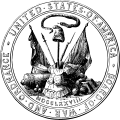
James Ewell Brown "Jeb" Stuart was a United States Army officer from Virginia who became a Confederate States Army general during the American Civil War. He was known to his friends as "Jeb", from the initials of his given names. Stuart was a cavalry commander known for his mastery of reconnaissance and the use of cavalry in support of offensive operations. While he cultivated a cavalier image, his serious work made him the trusted eyes and ears of Robert E. Lee's army and inspired Southern morale.
The Michigan Brigade, sometimes called the Wolverines, the Michigan Cavalry Brigade or Custer's Brigade, was a brigade of cavalry in the volunteer Union Army during the latter half of the American Civil War. Composed primarily of the 1st Michigan Cavalry, 5th Michigan Cavalry, 6th Michigan Cavalry and 7th Michigan Cavalry, the Michigan Brigade fought in every major campaign of the Army of the Potomac from the Battle of Gettysburg in July 1863 to the Confederate surrender at Appomattox Court House in April 1865.

John Buford, Jr. was a United States Army cavalry officer. He fought for the Union as a brigadier general during the American Civil War. Buford is best known for having played a major role in the first day of the Battle of Gettysburg on July 1, 1863, by obtaining the 'high ground' while in command of a division.
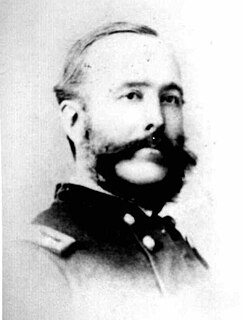
William Gamble was a civil engineer and a United States Army cavalry officer. He served during the Second Seminole War, and fought for the Union during the American Civil War. He commanded one of two brigades in Brigadier General John Buford's Division of Cavalry, in which he played an important role in defending Union positions during the first day of the Battle of Gettysburg.
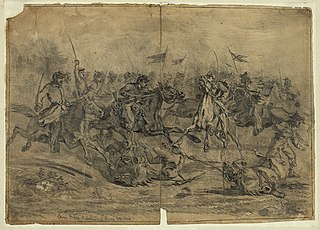
The Battle of Brandy Station, also called the Battle of Fleetwood Hill, was the largest predominantly cavalry engagement of the American Civil War, as well as the largest ever to take place on American soil. It was fought on June 9, 1863, around Brandy Station, Virginia, at the beginning of the Gettysburg Campaign by the Union cavalry under Maj. Gen. Alfred Pleasonton against Maj. Gen. J.E.B. Stuart's Confederate cavalry.
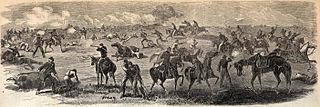
The Battle of Upperville took place in Loudoun County, Virginia on June 21, 1863 during the Gettysburg Campaign of the American Civil War.
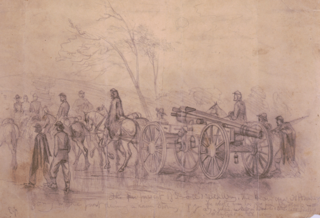
The Battle of Williamsport, also known as the Battle of Hagerstown or Falling Waters, took place from July 6 to July 16, 1863, in Washington County, Maryland, as part of the Gettysburg Campaign of the American Civil War. It is not to be confused with the fighting at Hoke's Run which was also known as the Battle of Falling Waters.

Wesley Merritt was an American major general who served in the cavalry of the United States Army during the American Civil War, American Indian Wars, Spanish–American War, and the Philippine–American War. Following the latter war, he became the first American Military Governor of the Philippines.

Alfred Pleasonton was a United States Army officer and major general of volunteers in the Union cavalry during the American Civil War. He commanded the Cavalry Corps of the Army of the Potomac during the Gettysburg Campaign, including the largest predominantly cavalry battle of the war, Brandy Station. In 1864, he was transferred to the Trans-Mississippi Theater, where he defeated Confederate General Sterling Price in two key battles, including the Battle of Mine Creek, the second largest cavalry battle of the war, effectively ending the war in Missouri. He was the son of Stephen Pleasonton and younger brother of Augustus Pleasonton.

The Gettysburg campaign was a military invasion of Pennsylvania by the main Confederate army under General Robert E. Lee in summer 1863. The Union won a decisive victory at Gettysburg, July 1–3, with heavy casualties on both sides. Lee managed to escape back to Virginia with most of his army. It was a turning point in the American Civil War, with Lee increasingly pushed back toward Richmond until his surrender in April 1865. After his victory in the Battle of Chancellorsville, Lee's Army of Northern Virginia moved north for a massive raid designed to obtain desperately needed supplies, to undermine civilian morale in the North, and to encourage anti-war elements. The Union Army of the Potomac was commanded by Maj. Gen. Joseph Hooker and then by Maj. Gen. George G. Meade.

David McMurtrie Gregg was a farmer, diplomat, and a Union cavalry general in the American Civil War.

Hugh Judson Kilpatrick was an officer in the Union Army during the American Civil War, achieving the rank of brevet major general. He was later the United States Minister to Chile and an unsuccessful candidate for the U.S. House of Representatives.

Elon John Farnsworth was a Union Army captain in the American Civil War. He commanded Brigade 1, Division 3 of the Cavalry Corps from June 28, 1863 to July 3, 1863, when he was mortally wounded and died at the Battle of Gettysburg. He was nominated by President Abraham Lincoln for appointment to the grade of brigadier general on June 29, 1863 but was not confirmed by the United States Senate before his death at Gettysburg.

The American Civil War saw cavalry tactics move largely away from the offensive towards the defensive, with the emphasis on screening, reconnaissance, raiding and harassment. Development of the rifled musket had also rendered the cavalry charge impractical.

On the third day of the Battle of Gettysburg during the disastrous infantry assault nicknamed Pickett's Charge, there were two cavalry battles: one approximately three miles (5 km) to the east, in the area known today as East Cavalry Field, the other southwest of the [Big] Round Top mountain.

Thomas Casimer Devin was a United States Army officer and general. He commanded Union cavalry during the American Civil War and during the Indian Wars.
Pennock Huey was an officer and cavalry brigade commander in the Union Army during the American Civil War.

The Confederate Army of Northern Virginia began its Retreat from Gettysburg on July 4, 1863. Following General Robert E. Lee's failure to defeat the Union Army at the Battle of Gettysburg, he ordered a retreat through Maryland and over the Potomac River to relative safety in Virginia. The Union Army of the Potomac, commanded by Maj. Gen. George G. Meade, was unable to maneuver quickly enough to launch a significant attack on the Confederates, who crossed the river on the night of July 13–14.

Ira Wallace Claflin was a United States Army West Point regular officer who took command of the 6th US Cavalry during the critical days of July 1863 during the Gettysburg Campaign. He was an instructor of Union cavalry tactics for West Virginia and later taught at West Point.

The Battle of Fairfax Court House was fought during the Gettysburg Campaign of the American Civil War between two cavalry detachments from the Union Army of the Potomac, commanded by General Joseph Hooker, and the Confederate Army of Northern Virginia, commanded by General Robert E. Lee.


















